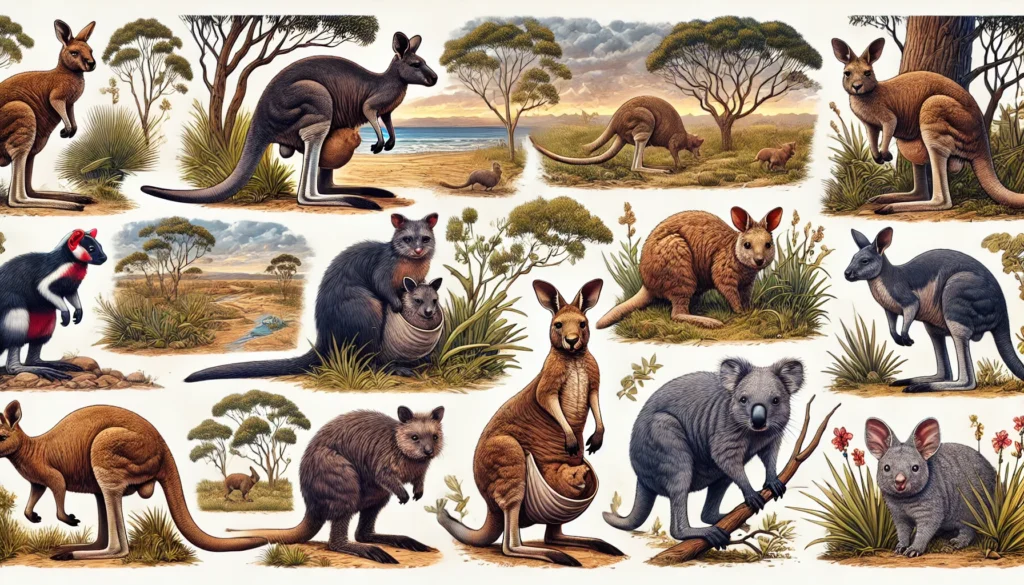When thinking of animals with pouches, the kangaroo often comes to mind first. However, many other creatures share this fascinating trait. Known as marsupials, these animals have evolved to carry and nurture their young in specialized pouches. While kangaroos and koalas are the most famous examples, this article will introduce you to seven lesser-known animals with pouches, revealing the diversity and unique adaptations of marsupials across the world.
1. Kangaroo
No list of animals with pouches would be complete without the iconic kangaroo. Native to Australia, kangaroos are part of the marsupial family known for their large, muscular hind legs and ability to hop at high speeds. The pouch, or marsupium, is found in female kangaroos and serves as a crucial part of their reproductive strategy.
After giving birth to a tiny, underdeveloped joey, the mother places it into her pouch, where the baby attaches itself to a teat and continues to develop. The joey remains in the pouch for several months, receiving nourishment and protection until it’s strong enough to venture outside.
A Perfect Design
The pouch allows the mother to protect and nurture her young while remaining mobile. Kangaroos are constantly on the move, grazing and avoiding predators, and the pouch enables them to continue this lifestyle while caring for their offspring.
2. Koala
The koala is another well-known Australian marsupial, famous for its slow, tree-dwelling lifestyle and eucalyptus diet. Female koalas also have a pouch, although it’s oriented differently from that of a kangaroo. The koala’s pouch opens towards the rear, providing extra protection from the debris that can accumulate as the animal climbs trees.
Like kangaroos, koalas give birth to tiny, underdeveloped young, known as joeys, which crawl into the pouch immediately after birth. Inside the pouch, the joey continues to develop, feeding on its mother’s milk until it is ready to leave the pouch and begin exploring its environment.
Unique Pouch Orientation
The koala’s backward-facing pouch helps keep the joey safe and clean while its mother navigates through branches and trees. This small adaptation is crucial for a life spent almost entirely in the treetops.
3. Wombat
The wombat is a lesser-known but equally fascinating marsupial. Wombats are burrowing animals found in Australia, and like their marsupial relatives, female wombats have pouches to carry their young. However, wombat pouches are unique in that they open toward the rear, similar to koalas.
This backward-facing pouch is an essential adaptation for wombats, who spend much of their time digging underground burrows. If their pouches opened forward like a kangaroo’s, dirt and debris would quickly fill the pouch, posing a risk to the joey inside.
Burrowing Adaptations
Wombats are known for their powerful claws and strong legs, which they use to dig extensive tunnel systems. The pouch placement ensures that wombats can continue their burrowing activities without compromising the safety and cleanliness of their young.
4. Tasmanian Devil
The Tasmanian devil is a carnivorous marsupial native to Tasmania, Australia. Known for its loud screeches and aggressive feeding habits, the Tasmanian devil also possesses a pouch. Female Tasmanian devils give birth to litters of underdeveloped young, which crawl into the mother’s pouch immediately after birth.
Inside the pouch, the young latch onto a teat and remain there for about four months, developing fully before leaving the pouch. Tasmanian devils are solitary animals, and the pouch provides a safe, nurturing environment for the joeys as the mother hunts and defends her territory.
Protective Parenting
The Tasmanian devil’s pouch is essential for protecting its young in the wild, where they face threats from other animals and environmental factors. The pouch offers a secure space for the joeys to grow before they are ready to fend for themselves.
5. Numbat
The numbat is a lesser-known marsupial that stands out for its unique appearance and insect-eating diet. Found in the woodlands of western Australia, numbats primarily feed on termites, using their long, sticky tongues to extract their prey from logs and soil. Unlike most marsupials, numbats do not have a permanent pouch.
Instead, female numbats develop folds of skin around their abdomen during the breeding season, creating a temporary protective space for their young. The young numbats attach themselves to the mother’s teats and remain in this makeshift pouch for several months until they are ready to leave and begin exploring their environment.
Temporary Pouch
The numbat’s temporary pouch is an intriguing adaptation, allowing the mother to protect her young during the early stages of development without the need for a permanent marsupium. This unusual approach to parenting sets numbats apart from other marsupials.
6. Quokka
The quokka, often called the world’s happiest animal due to its friendly appearance, is a small marsupial native to Australia. Like other marsupials, female quokkas have pouches where they carry and nurture their young. Quokkas give birth to a single joey, which remains in the pouch for about six months, receiving nourishment and protection.
Quokkas are social animals, often living in small groups. Their pouches provide an essential means of keeping their young safe while they forage for food in the wild.
A Friendly Marsupial
Despite their cute and approachable appearance, quokkas rely on their pouches to ensure the survival of their offspring in the wild. The pouch offers a secure space where the joey can grow without being exposed to the dangers of their environment.
7. Sugar Glider
The sugar glider is a small, nocturnal marsupial known for its ability to glide between trees using a membrane of skin that stretches from its wrists to its ankles. Native to Australia, New Guinea, and Indonesia, sugar gliders are highly social animals that live in large colonies. Female sugar gliders have pouches where they carry their underdeveloped young, known as joeys.
After giving birth, the tiny joey crawls into the pouch, where it attaches itself to a teat and continues to develop. Sugar gliders typically give birth to one or two joeys at a time, and the joeys remain in the pouch for about two months before venturing out.
Gliding and Parenting
The sugar glider’s ability to glide is an impressive adaptation that allows it to travel between trees with ease. The pouch plays a crucial role in the early stages of the joeys’ development, ensuring they are safe while their mother navigates the treetops.
Conclusion
Marsupials are a diverse and fascinating group of animals that have evolved a unique way to care for their young. From the well-known kangaroo and koala to the lesser-known numbat and quokka, each of these animals uses its pouch to protect and nurture its offspring. Whether it’s the forward-facing pouch of the kangaroo or the temporary pouch of the numbat, these adaptations demonstrate the incredible diversity and ingenuity of nature.
FAQ
Why do marsupials have pouches?
Marsupials have pouches to protect and nurture their underdeveloped young, known as joeys. Since marsupial babies are born in an early stage of development, they crawl into their mother’s pouch to continue growing, feeding on her milk.
How long do joeys stay in the pouch?
The length of time a joey stays in the pouch depends on the species. For example, kangaroo joeys remain in the pouch for about six to nine months, while sugar glider joeys stay in the pouch for around two months.
Do male marsupials have pouches?
No, male marsupials typically do not have pouches. In most marsupial species, only the females have pouches to carry and protect their young.
Are there marsupials outside of Australia?
Yes, while most marsupials are found in Australia and surrounding islands, there are also marsupials in the Americas. The most well-known example is the opossum, which is native to North and South America.
What’s the difference between a kangaroo pouch and a koala pouch?
The main difference between a kangaroo pouch and a koala pouch is the orientation. A kangaroo’s pouch opens forward, while a koala’s pouch opens towards the rear. This difference helps koalas keep their pouches clean as they climb trees.
Do all marsupials have permanent pouches?
No, not all marsupials have permanent pouches. For example, the numbat has a temporary pouch that forms during the breeding season to protect its young, but it doesn’t have a permanent pouch like kangaroos or wombats do.


